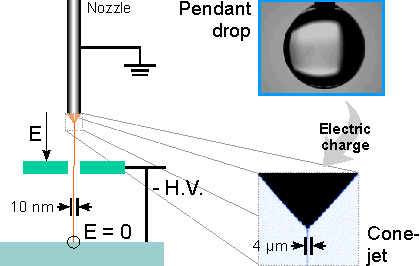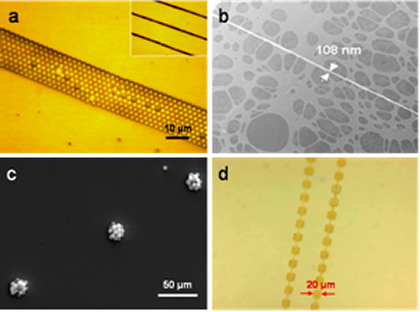Research: Electrohydrodynamic Liquid Bridge Printing (ELBP)
Sibel Korkut
Advisors: Dudley A. Saville and Ilhan A. Aksay
The ability to decorate surfaces with micron or nanometer-scale features is of increasing importance for many areas of research and technology. For example, production of integrated circuits from polymer semi conductors requires handling of polymers in the micro-scale. Some of the length scales in transistor components, like the channel length of source-drain electrodes, are of fundamental importance for the performances of these transistors [1]; therefore high resolution patterning is desired. Existing direct write techniques are unable to meet the demands of these applications due to their shortcomings: resolution of ink jet printing [1-3] and direct write assembly technique [4] are restricted by the nozzle size, whereas the speed of dip pen technique [5] is limited by the ‘ink’ transfer rate. We have been developing a fast and high resolution direct printing method, which permits rapid prototyping of microstructures/nanostructures with an exquisite degree of external control over the internal structure of patterned materials.
Our method is based on deformation of droplets suspended from a nozzle into a conical shape, called a Taylor cone [6, 7], by application of large electric fields. At higher field strengths, electrical stresses overcome surface tension and a thin filament of liquid is emitted from the tip of the cone. Patterns can be formed by continuously supplying liquid to the nozzle while moving the filament across a surface.

Figure 1: Schematic of Taylor cone formation and ELB.
If not prevented, the electrified liquid filament is subject to several forms of instability in the downstream. Charge on the filament can cause non-axisymmetric (whipping) motions and capillary forces can lead to an axisymmetric (varicose) breakup. Under certain conditions, however, these instabilities are reduced extensively. This is the electrohydrodynamic liquid bridge (ELB) configuration [8] (see Figure 1). To gain a better understanding of the stability of ELB, we observe motions of the filament using a fast imaging system that can acquire images at rates as high as 10 kHz with exposure times as low as 2 μs, then analyze the images using Matlab.

Figure 2: Patterns formed from polymeric mixtures (b,d), and suspensions of of 2µm (a) and 6µm (c) polystyrene spheres using ELB. Figures 2a and 2b are from [8].
Our experiments showed that growth rate of the non-axisymmetric disturbances are significantly slower in ELB configuration compared to the familiar electrospinning configuration under the same operating conditions; confirming that ELB is fundamentally different than electrospinning in which the liquid filament consists of a straight section at the upstream of a rapidly oscillating part that often splits into two or more parts. Using the ELB configuration, we produced lines with colloids as small as a few microns [8] (Figure 2a), 3D colloidal crystals (Figure 2c) and different kinds of polymeric patterns as shown in Figure 2. Current research is concentrated on identifying with the reasons of the improved stability of ELB.
For more information on this research topic, please contact Sibel Korkut. Additional information concerning the CML can be found on our website.
References
1. A. Knobloch, A. Manuelli, A.Bernds, W. Clemens, J. Appl. Phys. 96 4 2286 (2004)
2. B. De Gans, U.S. Schubert, Langmuir 20 7789 (2004)
3. N. Stutzmann, R.H. Friend, H. Sirringhaus, Science 299 1881 (2003)
4. D. Therriault, S.R. White, J.A. Lewis, Nature 2 265 (2003)
5. C.A. Mirkin, S. Hang, Science 288 1808 (2000)
6. J Zeleny, Phys. Rev. 3 69 (1914)
7. G.I. Taylor, Proc. R. Soc. London, Ser. A 280 383 (1964)
8. H.F. Poon, PhD Thesis, Princeton University, Department of Chemical Engineering (2002)
![]()
![]()
![]() © 2006 Princeton University, Ceramic Materials Laboratory.All Rights Reserved.
© 2006 Princeton University, Ceramic Materials Laboratory.All Rights Reserved.


